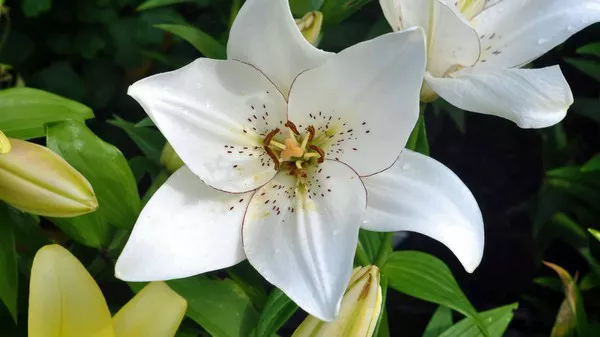Flowers have played an intricate role in human culture for centuries, serving as symbols that communicate emotions, events, and even concepts that might be difficult to express through words alone. One of the most intriguing and enigmatic facets of floral symbolism is the association of certain flowers with death. While flowers are generally linked with life, beauty, and growth, there are specific blooms that have been historically and culturally linked to the concept of mortality. This article delves into the intriguing realm of flowers that symbolize death, examining their historical significance, cultural interpretations, and the broader context within which these symbols emerge.
The Enigmatic Connection: Flowers and Death
Flowers have long been employed as tokens of remembrance and expressions of sympathy during times of loss and mourning. The choice of specific flowers to represent death is a complex interplay of historical events, cultural beliefs, and the intrinsic characteristics of the flowers themselves.
1. The Elegance of the Lily
Lily, often associated with purity and grace, carries dual symbolism when it comes to death. In Western cultures, the white lily is considered a symbol of innocence and virtue, often adorning funerals and memorial services. Its association with death draws from its role in Christian iconography, where the Archangel Gabriel is depicted offering a lily to the Virgin Mary, signifying her purity even in the face of her son’s impending death.
2. Mysterious Beauty of the Orchid
Orchids, with their exotic and delicate beauty, have varying interpretations in different cultures. In some Asian societies, orchids represent the cycle of life, including birth, death, and rebirth. The fleeting nature of an orchid’s bloom aligns with the transient quality of life, making it a symbol of both beauty and impermanence.
3. Solemnity of the Chrysanthemum
Chrysanthemums, especially in Eastern cultures like Japan, hold deep associations with death and the afterlife. They are used as offerings on graves and altars, and in Japan, the Chrysanthemum Festival, also known as “Chrysanthemum Day,” is a time for families to honor their ancestors. The flower’s intricate petals and numerous layers mirror the layers of life and death, emphasizing the complex connection between the two.
4. Purity and Transition: White Flowers
White flowers in general often symbolize purity, innocence, and transition, making them a common choice for funerals across cultures. Flowers like white roses, white carnations, and white lilies are often chosen to express sympathy and convey the idea of the soul’s purity and transition to the afterlife.
Cultural Perspectives on Flowers and Death
Cultural interpretations of flowers associated with death reveal fascinating insights into how societies perceive mortality and spirituality.
1. Eastern Perspectives
In Asian cultures, such as Japan and China, death is often viewed as a natural part of the cycle of life. This perspective is reflected in the choice of flowers like chrysanthemums and lotus, which are considered symbols of rebirth, enlightenment, and the continuity of life beyond death.
2. Western Perspectives
In Western societies, death is frequently approached with a mix of solemnity and hope. Flowers like lilies and roses are used to honor the deceased and provide solace to the bereaved. The emphasis here often lies in celebrating the life that was lived and expressing condolences to those left behind.
3. Religious Symbolism
Religious beliefs also significantly influence the choice of flowers linked to death. In Christianity, for instance, the Easter Lily is not only a symbol of resurrection but also holds associations with the Virgin Mary, creating a bridge between life, death, and divine intervention.
4. Historical Influences
Throughout history, flowers have been chosen as emblems of specific events or personalities. When historical figures pass away, certain flowers are adopted to pay homage to their memory. For example, black dahlias were used to commemorate the death of artist Salvador Dali, adding a layer of personal symbolism to the broader concept of flowers and death.
Navigating Modern Interpretations
As societies evolve, so too do the meanings associated with these symbolic flowers. While the traditional interpretations of flowers linked to death persist, modern interpretations reflect changing attitudes towards life, death, and mourning.
1. Celebration of Life
In contemporary times, there is a growing emphasis on celebrating a person’s life rather than dwelling solely on their passing. This shift is mirrored in the choice of vibrant and colorful flowers that signify the joyous aspects of life rather than the mournful aspects of death.
2. Personalized Mourning
With the rise of personalization in all aspects of life, mourning and memorialization have also become more individualized. Families now select flowers that resonate with the deceased’s personality, hobbies, or even favorite colors, creating a unique tapestry of symbolism.
3. Global Exchange of Symbolism
In our interconnected world, cultural exchange has led to the melding of traditional symbols and interpretations. Flowers that once held specific meanings in one culture are now adopted and appreciated in different contexts, enriching the universal language of flowers.
Conclusion
The intricate connection between flowers and death unveils a profound blend of history, culture, and emotion. As society continues to evolve, so too does the symbolism attached to these blooms. Whether representing the cycle of life and rebirth or providing solace to those who mourn, these flowers serve as poignant reminders of the intricate relationship between life and death – a relationship that is as complex and beautiful as the flowers themselves.


